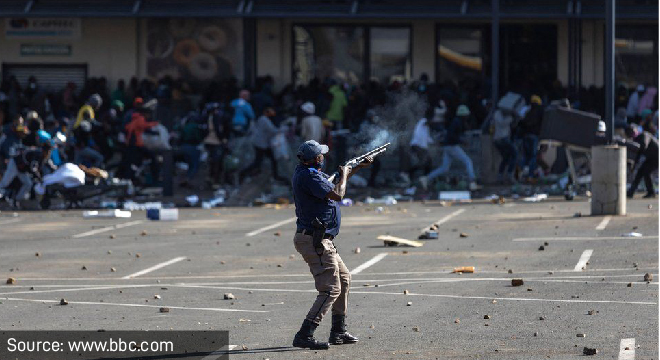Lloyd’s of London believes it is likely there will be a recurrence of last year’s riots, and has hiked its reinsurance premiums paid by the South African Special Risk Association (Sasria).
Sasria briefed the National Council of Provinces’ Select Committee on Finance this week.
Incoming chief executive Mpumi Tyikwe told the committee that Sasria would not settle claims for the looting that occurred after the floods in KwaZulu-Natal.
“The looting is the consequence of the flooding. The proximate cause is not any of the perils that Sasria covers,” Tyikwe said.
Reinsurance premium hiked
Lloyd’s has increased its reinsurance premium to Sasria by more than 1 000%, because the country’s high level of poverty and unemployment meant it was likely that last year’s rioting and looting could happen again in the next two to three years.
Sasria’s executive manager for stakeholder management, Muzi Dladla, told Business Day that because Lloyd’s was the market leader, it set the terms for reinsurance. Sasria was unable to find alternative reinsurance on better terms after Lloyd’s raised its rates.
Sasria has reduced the level of reinsurance from Lloyd’s.
As a result of the significantly higher cost of reinsurance, Sasria would seek a further capital injection from the government, in addition to the R22 billion it gave the company to meet its claims obligations. Sasria has not yet determined how much would be required and what form the injection should take, Business Day reported.
Tyikwe said that Sasria has withdrawn its optional excess of loss cover of R1.5bn for big corporates, because it could not get support from reinsurers.
Cover for all clients has been restricted to R500 million per legal entity, which was “clearly not adequate”.
However, clients that sought wrap cover from Lloyd’s will find that, in some cases, premiums have been increased by more than 10 times compared to 2020. This was because Lloyd’s has taken the view that what happened in July is likely to recur, Tyikwe said.
Solvency ratio above 100% ‘will be achieved’
Despite the R22bn injection from National Treasury, Sasria’s preliminary financial results for 2021/22 indicate it will make a loss of R26bn after tax, compared to a profit of R1.5bn in 2020/21. Gross premium income was R3bn, total claims came to R37.7bn, and reinsurance cost R2.9bn.
Sasria’s insurance contract liabilities were projected to rise from R1.3bn in 2020/21 to R15.8bn in 2021/22.
However, Tyikwe told MPs he was “more than confident” that Sasria has enough cash to pay all its claims and meet its capital requirements by the middle of this year.
He said Sasria’s solvency capital ratio was currently 68%, after falling to -347% in November last year.
The Prudential Authority has instructed Sasria to get its solvency ratio above 100% by June.
Sasria projects that, based on the capital injection of R22bn and claims of R37bn, its solvency ratio will be 115% in June, assuming it settles 90% of riot-related claims, Tyikwe said.
Sasria’s scenario planning indicated that if it were to experience a R3bn claim after June, its solvency ratio would drop from 115% to 91%.
“What this means is that we are not yet strong […] We are still quite vulnerable, and we have to build the business using the premium increases and so on to get us stronger,” Tyikwe said.
The insurer has factored in the likelihood that it will pay claims for more riots, but “we would like to believe they will not be as significant, given the unique circumstances that surrounded the July unrest”, he said.
Its balance sheet was not strong enough to sustain an event similar to the July riots that results in a R37bn loss in the next year or two.
‘Lack of police response exacerbated losses’
Tyikwe said Sasria’s premiums and risk scenarios were based on the assumption that the police will respond to unrest timeously.
He said losses were not that significant by day five of the nine-day July riots. But once people realised the security response was lacking, the rioting accelerated in the last four days.
Sasria had not foreseen this in its scenarios, which is why its losses were far bigger than anticipated.
Commenting on the report by the panel appointed by President Cyril Ramaphosa to investigate the riots, Tyikwe said the intelligence community had forecast there was a greater likelihood of social unrest in 2021.
Sasria would like the state’s intelligence agencies to share this sort of information with it in future, so the insurer could plan better.
Sasria was working with its clients on ways they could improve security at their premises.
However, he said the long-term solution to preventing a recurrence of the July unrest was not higher walls but increasing participation in the economy.
Outstanding claims
About 30% of claims from the July unrest were still outstanding.
However, by claim band, 95% of claims below R1m have been settled, while 74% of claims between R1m and R10 have been settled, Tyikwe said.
Less than 1% of the number of claims were responsible for 64% of the rand value of claims, and Sasria believes it will achieve its target of settling 90% of claims by June if it focuses on that 1%.
The reasons claims remain unsettled include that Sasria has opted to reinstate, instead of paying cash. Therefore, approved claims will reflect as outstanding while Sasria waits for invoices for each stage of rebuilding a property.
Another reason is that some small businesses are struggling to formulate claims, because their financial records were destroyed during the riots. Sasria’s loss adjusters were assisting, where they could, to compile financial records. Where this was not possible, Sasria has advised claimants to submit their most recent tax return.



